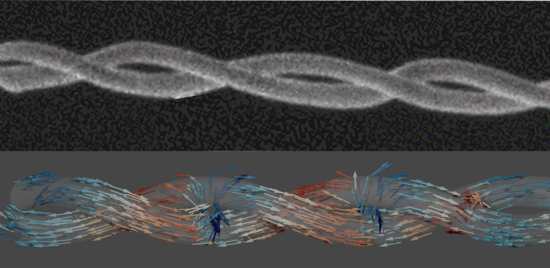University of Cambridge: 3D Printed Nanomagnets Unveil World of Patterns in Magnetic Field
Magnetic double helices produce nanoscale topological textures in magnetic field, something that had never been seen before, opening door to next gen of magnetic devices.
This is a Press Release edited by StorageNewsletter.com on December 30, 2021 at 2:00 pm By Vanessa Bismuth, Cavendish Laboratory, University of Cambridge
By Vanessa Bismuth, Cavendish Laboratory, University of Cambridge
Scientists have used state-of-the-art 3D printing and microscopy to provide new glimpse of what happens when taking magnets to three-dimensions on the nanoscale – 1,000x smaller than human hair.
Nanoscale magnetic double helices (top) are found to host highly coupled textures, observed both experimentally and with simulations (bottom).
(Credit: Claire Donnelly)
The international team led by Cambridge University’s Cavendish Laboratory used an advanced 3D printing technique they developed to create magnetic double helices – like the double helix of DNA – which twist around one another, combining curvature, chirality, and strong magnetic field interactions between the helices.
“If we can control those magnetic forces on the nanoscale, we get closer to reaching the same degree of control as we have in two dimensions. This could offer new possibilities for particle trapping, imaging techniques as well as smart materials.” said Claire Donnelly
Doing so, the scientists discovered that these magnetic double helices produce nanoscale topological textures in the magnetic field, something that had never been seen before, opening the door to the next generation of magnetic devices. The results are published in Nature Nanotechnology.
Magnetic devices impact many different parts of our societies, magnets are used for the generation of energy, for data storage and computing. But magnetic computing devices are fast approaching their shrinking limit in two-dimensional systems. For the next generation of computing, there is growing interest in moving to three dimensions, where not only can higher densities be achieved with 3D nanowire architectures, but three-dimensional geometries can change the magnetic properties and offer new functionalities.
“There has been a lot of work around a yet-to-be-established technology called racetrack memory, first proposed by Stuart Parkin. The idea is to store digital data in the magnetic domain walls of nanowires to produce information storage devices with high reliability, performance and capacity,” said Claire Donnelly, study’s first author from Cambridge’s Cavendish Laboratory, who has recently moved to the Max Planck Institute for Chemical Physics of Solids.
“But until now, this idea has always been very difficult to realise, because we need to be able to make three-dimensional magnetic systems and we also need to understand the effect of going to three dimensions on both the magnetisation and the magnetic field.”
“So, over the last few years our research has focused on developing new methods to visualize three dimensional magnetic structures – think about a CT scan in a hospital, but for magnets. We also developed a 3D printing technique for magnetic materials.”
The 3D measurements were performed at the PolLux beamline of the Swiss Light Source, Paul Scherrer Institute, currently the only beamline able to offer soft X-ray laminography. Using these advanced X-ray imaging techniques, the researchers observed that the 3D DNA structure leads to a different texture in the magnetisation compared to what is seen in 2D. Pairs of walls between magnetic domains (regions where the magnetisation all points in the same direction) in neighbouring helices are highly coupled – and as a result, deform. These walls attract one another and, because of the 3D structure, rotate, ‘locking’ into place and forming strong, regular bonds, similar to the base pairs in DNA.
“Not only did we find that the 3D structure leads to interesting topological nanotextures in the magnetisation, where we are relatively used to seeing such textures, but also in the magnetic stray field, which revealed exciting new nanoscale field configurations!” said Donnelly.
“This new ability to pattern the magnetic field at this length scale allows us to define what forces will be applied to magnetic materials and to understand how far we can go with patterning these magnetic fields. If we can control those magnetic forces on the nanoscale, we get closer to reaching the same degree of control as we have in two dimensions.”
“The result is fascinating – the textures in the DNA-like double helix form strong bonds between the helices, deforming their shape as a result,” explained lead author Amalio Fernandez-Pacheco, former Cavendish Researcher, now working at the Institute of Nanoscience and Materials of Aragón. “But what is more exciting is that around these bonds form swirls in the magnetic field – topological textures!”
Having gone from two to three dimensions in terms of the magnetisation, now Donnelly and her collaborators from the Paul Scherrer Institute and Universities of Glasgow, Zaragoza, Oviedo, and Vienna will explore the full potential of going from two to three dimensions in terms of the magnetic field.
“The prospects of this work are manyfold: these strongly bonded textures in the magnetic helices promise highly robust motion and could be a potential carrier of information,” said Fernandez-Pacheco. “Even more exciting is this new potential to pattern the magnetic field at the nanoscale, this could offer new possibilities for particle trapping, imaging techniques as well as smart materials.“
Article: Complex free-space magnetic field textures induced by three-dimensional magnetic nanostructures
Nature Nanotechnology has published an article written by Claire Donnelly, Cavendish Laboratory, University of Cambridge, Cambridge, UK, now Max Planck Institute for Chemical Physics of Solids, Dresden, Germany, Aurelio Hierro-Rodríguez, SUPA, School of Physics and Astronomy, University of Glasgow, Glasgow, UK, Departamento de Física, Universidad de Oviedo, Oviedo, Spain, and CINN (CSIC–Universidad de Oviedo), El Entrego, Spain, Claas Abert, University of Vienna Research Platform MMM Mathematics–Magnetism–Materials, Vienna, Austria, Katharina Witte, Swiss Light Source, Paul Scherrer Institute, Villigen, Switzerland, and Berlin Partner für Wirtschaft und Technologie GmbH, Berlin, Germany, Luka Skoric, Dédalo Sanz-Hernández, Cavendish Laboratory, University of Cambridge, Cambridge, UK, Simone Finizio, Swiss Light Source, Paul Scherrer Institute, Villigen, Switzerland, Fanfan Meng, Cavendish Laboratory, University of Cambridge, Cambridge, UK, Stephen McVitie, SUPA, School of Physics and Astronomy, University of Glasgow, Glasgow, UK, Jörg Raabe, Swiss Light Source, Paul Scherrer Institute, Villigen, Switzerland, Dieter Suess, University of Vienna Research Platform MMM Mathematics–Magnetism–Materials, Vienna, Austria, Russell Cowburn, Cavendish Laboratory, University of Cambridge, Cambridge, UK, and Amalio Fernández-Pacheco, Instituto de Nanociencia y Materiales de Aragón, CSIC-Universidad de Zaragoza, Zaragoza, Spain.
Abstract: “The design of complex, competing effects in magnetic systems—be it via the introduction of nonlinear interactions, or the patterning of three-dimensional geometries is an emerging route to achieve new functionalities. In particular, through the design of three-dimensional geometries and curvature, intrastructure properties such as anisotropy and chirality, both geometry-induced and intrinsic, can be directly controlled, leading to a host of new physics and functionalities, such as three-dimensional chiral spin states, ultrafast chiral domain wall dynamics and spin textures with new spin topologies. Here, we advance beyond the control of intrastructure properties in three dimensions and tailor the magnetostatic coupling of neighbouring magnetic structures, an interstructure property that allows us to generate complex textures in the magnetic stray field. For this, we harness direct write nanofabrication techniques, creating intertwined nanomagnetic cobalt double helices, where curvature, torsion, chirality and magnetic coupling are jointly exploited. By reconstructing the three-dimensional vectorial magnetic state of the double helices with soft-X-ray magnetic laminography, we identify the presence of a regular array of highly coupled locked domain wall pairs in neighbouring helices. Micromagnetic simulations reveal that the magnetization configuration leads to the formation of an array of complex textures in the magnetic induction, consisting of vortices in the magnetization and antivortices in free space, which together form an effective B field cross-tie wall The design and creation of complex three-dimensional magnetic field nanotextures opens new possibilities for smart materials, unconventional computing, particle trapping and magnetic imaging.“













 Subscribe to our free daily newsletter
Subscribe to our free daily newsletter
